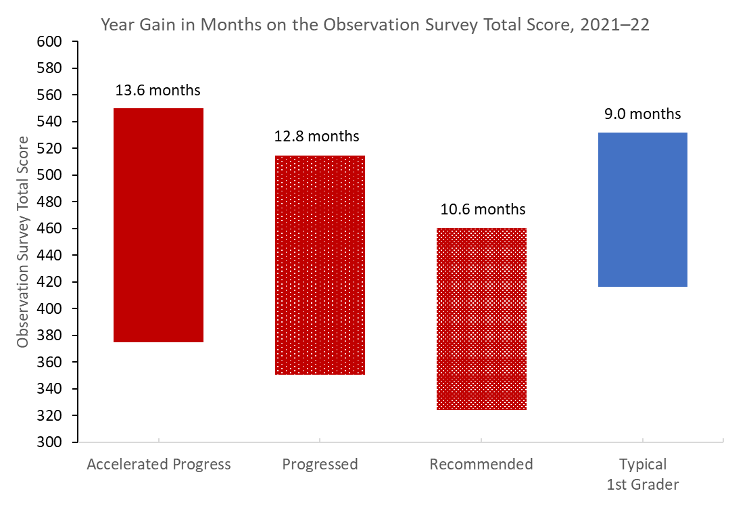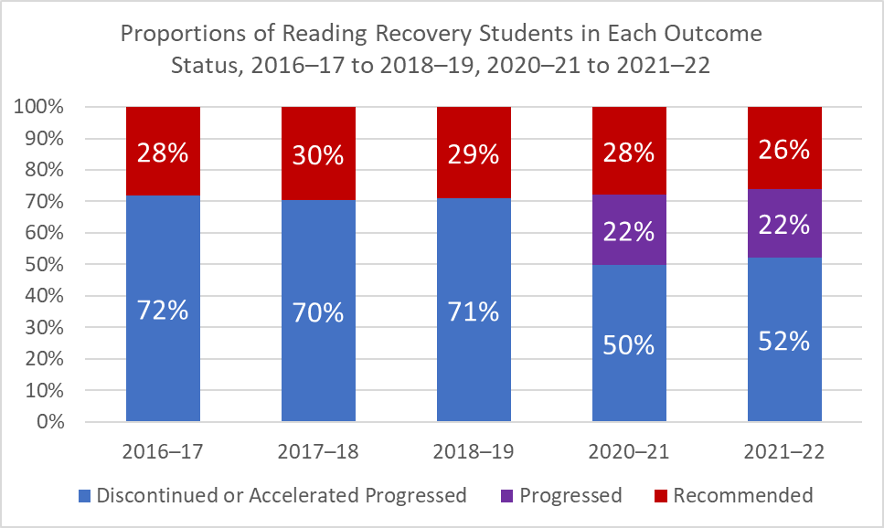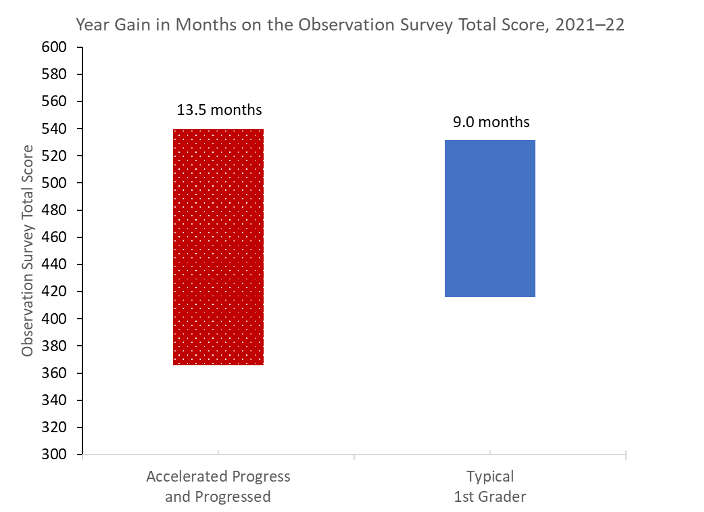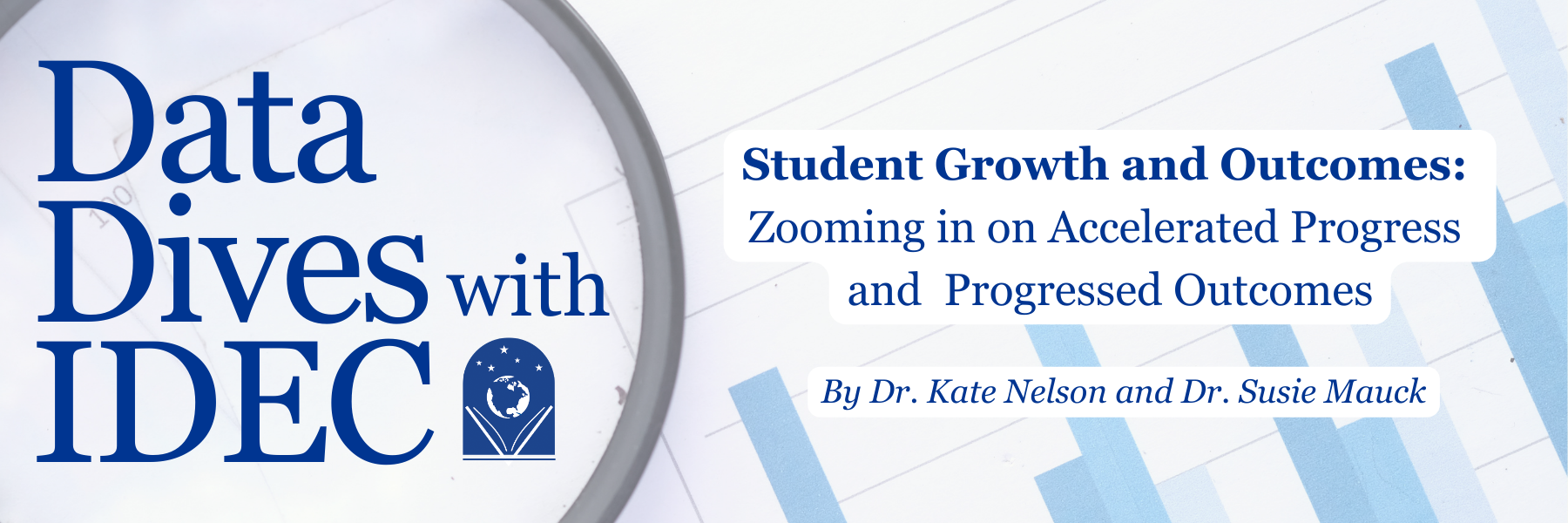BLOG
Student Growth and Outcomes: Zooming in on Accelerated Progress and Progressed Outcomes
By Dr. Kate Nelson and Dr. Susie Mauck
The latest data show that Reading Recovery is a highly effective intervention for children who struggle to learn to read. Here, we’ll take a closer look at data related to student growth.
In Reading Recovery, there are three main outcomes for full program students: Accelerated Progress, Progressed, and Recommended.
- Accelerated Progress means the child meets the intervention goal, achieving the class average, and can continue making progress without support beyond the classroom teacher.
- Progressed means the child made substantial progress but has not reached the class average and needs continued monitoring and support.
- Recommended means that while literacy progress was made, additional evaluation is needed, as well as ongoing support to help the child make progress.
This piece focuses on growth for students in these categories, with particular attention to children with outcomes of Accelerated Progress and Progressed.
Figure 1

In the figure above, we see that a child who exited Reading Recovery with an outcome status of Accelerated Progress averaged 13.6 months growth in their Observation Survey (OS) Total Score during the ninth-month school year. We also see that children with this outcome status started the school year with OS Total Scores that averaged 41 points lower than the average score of a typical first grader (375 compared to 416). Yet, these students ended the school year with an OS Total Score that averaged 18 points higher than the typical first grader (532 compared to 515). Thus, Reading Recovery children in this category made large gains from fall to year-end.
We also see that children with an outcome status of Progressed averaged 12.8 months of growth in a typical nine-month school year. These students started the school year with a lower average OS Total Score than children with Accelerated Progress (350 compared to 375), and the typical first grader (350 compared to 416). While they did not quite reach the class average by year-end, they closed the gap (515 on average compared to 532). Children in this category made substantial gains, averaging nearly 13 months growth in just nine months.
Finally, we have the category of Recommended, represented by the third bar in the graph. These children started school in the fall with the lowest OS Total Scores, averaging 92 points lower than the typical first grader (324 compared to 416). They averaged 10.6 months of growth in nine months’ time. Of note is that all three categories, Accelerated Progress, Progressed, and Recommended, made more than nine months’ growth.
Figure 2 shows the percentages for the different outcomes across five years. We see that from 2016 to 2019, approximately 70% of Reading Recovery children had an outcome of Discontinued (or what is now called Accelerated Progress) and approximately 30% of children had an outcome of Recommended. In 2020-21 and 2021-22, the category Discontinued was renamed Accelerated Progress, and the category of Progressed was introduced. We see the percentage of Accelerated Progress decreased to approximately 50%, Recommended was just below 30% and then dropped to 26%, and the Progressed category was stable at 22%. When looking across the years, we can see that the combination of Progressed and Accelerated Progress nearly equaled the previous years’ percentage of Discontinued at roughly 70%. The combined total of children with an outcome of Accelerated Progress or Progressed was 72% and 74% in 2020-21 and 2021-22, while in previous years children with an outcome status of Discontinued accounted for approximately 70% of Reading Recovery children. Consequently, we wonder whether most children in the Progressed category were previously included in the Discontinued category. The Progressed category may also be drawing some of the children away from the Recommended category as well. We are curious to see what happens with the category of Progressed as we continue to serve Reading Recovery children in the coming years.

We also were curious to see how many months of growth the students with the two positive outcomes (i.e., Accelerated Progress and Progressed) would have made if they were examined as one group. When combined, children in these categories averaged 13.5 months growth (Figure 3). This is important because in the 2021-22 school year, 74% of Reading Recovery children had an outcome of either Progressed or Accelerated Progress, indicating that almost three-fourths of Reading Recovery children had a positive outcome.
Figure 3

In conclusion, we see from the data that children in Reading Recovery made great strides in their literacy growth. Children with an outcome status of Accelerated Progress started the school year with significantly weaker literacy skills than the typical first grader, but surpassed their average score by year-end, averaging 13.6 months of growth in just nine months. Meanwhile, children with an outcome of Progressed averaged 12.8 months of growth. When combined, these categories account for 74% of children in Reading Recovery and 13.5 months of growth on average in their literacy skills. The data indicate that Reading Recovery effectively builds strong literacy skills in young readers, helping children who struggle to learn to read make substantial gains.

Kate Nelson is the IDEC International Data Evaluation Center Manager at The Ohio State University. She has a background in literacy, research, and teaching, and earned her Ph.D. in literacy education from The Ohio State University. At OSU, she received training in Reading Recovery and supervised children with reading difficulties in the university reading clinic. She worked with Dr. Lea McGee and colleagues to investigate first graders’ strategic use of information over time, resulting in a Reading Research Quarterly publication, as well as the International Literacy Association’s Dina Feitelson Research Award. She has experience in data analysis and research, as well as working with teachers in professional development and students in K-12 and higher education.

Susie Mauck was a public elementary school teacher before completing her doctorate at OSU in the College of Education and Human Ecology (EHE), Quantitative Research, Evaluation, and Measurement program. She specializes in quantitative methodology and has been supporting the work of the faculty and students in EHE since 2015.
THE JOURNAL OF READING RECOVERY
Spring 2025
OPEN ACCESS: Centering Children and Working Towards Equity: Teaching All Children to Read by Catherine Compton-Lilly
Literacy Leadership in Support of Equity: Whatever It Takes by Allison Briceño
Exploring the Purposes, Power, and Potential of Familiar Reading by Jamie Lipp
Full Circle: From Student to Psychologist by Joyce Romano




